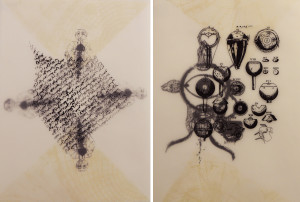Pantea Karimi
Two Time Art Party Participant
Averroes and Avicenna & Kepler and Alhazen
Artist’s Website
www.panteakarimi.com
Artist’s Statement
I have had a long-term interest in juxtaposed textual and pictorial elements. I am intrigued by the ways in which image and text interact and convey meaning. Following this interest, my current body of work explores the history of archaic technologies and investigates how older scientific knowledge was communicated through both image and text. I examine medieval and early modern scientific manuscripts—Persian, Arab and European—and the longue duree (long term) exchange of knowledge across these cultures. This process not only provides me with a great means to explore what I love—the relationship between image and text—but also expands my appreciation of science and its role in the visualization of abstract concepts. Moreover, by revisiting the scientific concepts through the lens of art, I highlight the significance of visual elements in science. Most of scientific manuscripts are filled with beautiful drawings and calligraphic texts. Others include interactive devices, such as volvelles (paper wheel charts) that accommodated calculation in many diverse subjects and used beautiful images, calligraphic texts and numbers. My series “Punctum Caecum,” which means “blind spot” in Latin, is the result of my exploration of ancient Arab, Persian and European scientific manuscripts.
In terms of abstraction and arrangement of my own forms, I draw inspiration from the Russian Suprematist artists El Lissitzky (1890-1941) and Kazimir Malevich (1878-1935). I render the pages of texts and diagrams of the scientific manuscripts and botanicals into black silhouettes. These black silhouettes provide me with a new visual form of engagement with scientific content and offer more compositional opportunities in my works. My black shapes aim to engage the “pure feelings” of my audiences through simplicity and absence of didactic information. I use silkscreen, ink, watercolor or graphite on paper as well as wood, vellum, felt and plexiglass to create a novel and dynamic visual interpretation of the scientific concepts presented in the manuscripts.
About the Artist
A resident of San Jose, California, Pantea Karimi earned her MFA in printmaking and painting from San Jose State University in 2009. She also holds a Diploma in printmaking and glass works from Hastings College of Arts and Technology in England and an MFA in graphic design from Art University in Tehran, Iran. Karimi’s fine art and graphic works have been featured in several publications in Iran, Italy, England and the United States. Her prints and digital works have been exhibited in various venues in Iran, Algeria, Germany, Mexico, England, and the United States, including the de Young Museum in San Francisco, 2012 ZERO1 Biennial, Yerba Buena Art Center in San Francisco, the New Bedford Art Museum in Massachusetts, and Platform in Munich, Germany. She is the recipient of the 2010 Distinguished Artist award by the City of Cupertino Fine Arts Commission; the 2011 Multicultural Arts Leadership Initiative fellowship; and the 2012 School of Arts and Culture grant in San Jose, California.
In addition to being an artist, Karimi has been teaching fine arts and computer graphics courses at all levels. She taught courses at San Jose State University as both Teaching Associate and Teaching Assistant between 2007 and 2010. Presently, Karimi teaches silkscreening techniques, fine arts and design courses at TechShop in San Jose, Cabrillo and De Anza Colleges.



